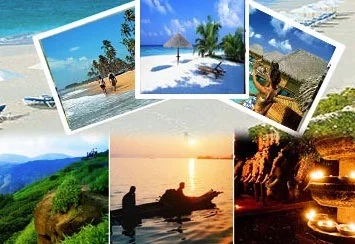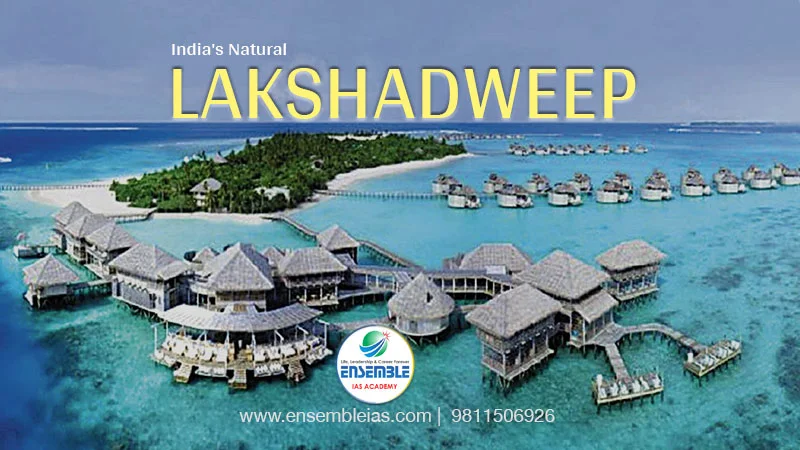Lakshadweep
Developing a world-class tourist destination is no easy feat, and it requires careful planning, strategic investments, and a deep understanding of the location’s unique characteristics. In the case of India’s natural gem, Lakshadweep, the challenges and opportunities for development are manifold.
Tourism in India has immense potential, with its rich cultural heritage, diverse landscapes, and historical sites attracting millions of visitors each year. With its pristine beaches, coral reefs, and unique marine biodiversity, Lakshadweep holds great promise as a world-class tourist destination. However, realising this potential requires addressing infrastructure limitations, ensuring sustainable development practices, and promoting responsible tourism to preserve the island’s fragile ecosystems.
Tourism as a potential for India.
Tourism has long been recognised as a potential catalyst for economic growth and development in India. With its diverse landscapes, rich cultural heritage, and ancient historical sites, the country has all the ingredients to become a world-class tourist destination. However, transforming this potential into reality requires careful planning, strategic investments, and a comprehensive infrastructure development and promotion approach.

India’s natural beauty and diverse landscapes make it an ideal destination for tourism. With its vast coastline and breath taking islands, it has the potential to develop world-class tourist destinations. One such place is Lakshadweep, a group of stunning coral islands in the Arabian Sea. Despite its natural beauty, the development of Lakshadweep as a tourist destination has faced its fair share of challenges and obstacles. To understand the present scenario, it is essential to delve into the short history of Lakshadweep and examine its current position in the tourism industry.
How is Lakshadweep placed?
Lakshadweep is a coral island chain of 36 islands, 12 atolls, three reefs, and five submerged banks. It is India’s smallest Union Territory. Lakshadweep is strategically located off the southwestern coast of India, making it easily accessible to both domestic and international tourists. Despite its small size, the archipelago offers many attractions, including pristine beaches, vibrant marine life, and unique cultural experiences. However, due to limited infrastructure and connectivity, Lakshadweep has struggled to capitalise on its tourism potential fully. The government is trying to improve transportation links and develop necessary amenities to attract more visitors and establish Lakshadweep as a world-class tourist destination.
Lakshadweep, a group of beautiful islands in the Arabian Sea, holds immense potential as a tourist destination. Its pristine beaches, crystal-clear waters, and vibrant marine life all attract travellers worldwide. However, tourism development in Lakshadweep faces unique challenges due to its remote location and fragile ecosystem. Efforts must be made to balance promoting tourism and preserving the natural beauty and biodiversity of the islands.
Lakshadweep islands lie about 220 to 440 km off the Kerala coast and are currently positioned as a niche destination, catering to discerning travellers seeking an untouched paradise. The government and local authorities have implemented sustainable tourism practices to minimise environmental impact, such as limiting visitor numbers and promoting responsible tourism activities. By striking a delicate balance between development and conservation, Lakshadweep can continue to thrive as a sustainable and sought-after tourist destination in the years to come.

The area has only ten inhabited islands: Agatti, Amini, Andrott, Bitra, Chetlat, Kadmat, Kalpeni, Kavaratti, Kiltan, and Minicoy. One must obtain permission from the administration to visit these islands, as they are restricted areas. However, sports take care of the permit formalities for genuine tourists. Lakshadweep’s restricted areas policy ensures that the delicate ecosystem of the ten inhabited islands remains protected from over-tourism. This approach allows genuine tourists to experience the region’s beauty while minimising any negative environmental impact.
The airport in Agatti offers helicopter transfers to Kavaratti Island. The remote islands provide a peaceful and pristine getaway for holidaymakers. The remote islands provide a peaceful and pristine getaway for holidaymakers, with crystal-clear waters and untouched beaches.
A short history of Lakshadweep.
With its breath taking natural beauty and pristine beaches, Lakshadweep has long been considered a potential world-class tourist destination for India. However, the journey towards achieving this status has been both challenging and rewarding. To understand the current position of Lakshadweep as a tourist destination, it is essential to delve into its rich history, which showcases its unique cultural heritage and the struggles it has faced in its development.
India’s natural treasure, Lakshadweep, has the potential to become a world-class tourist destination. With its stunning beaches, vibrant marine life, and picturesque landscapes, it has all the ingredients to attract travellers from across the globe. However, developing it into a tourism hotspot comes with its own set of challenges and considerations. To understand the path ahead, it is essential to analyse how Lakshadweep is currently positioned and delve into its historical background.
What has the government been doing for Lakshadweep?
The government has been actively involved in developing and promoting tourism in Lakshadweep. Several initiatives have been taken in recent years to attract tourists and improve the islands’ infrastructure. The Ministry of Tourism has been working closely with the local administration to identify and address the challenges faced by the tourism industry in Lakshadweep. Various projects have been implemented to enhance island connectivity, such as introducing regular flights and developing better transportation facilities. Additionally, efforts have been made to promote eco-tourism and preserve the island’s fragile ecosystem. The government has also encouraged private sector investments in the hospitality industry, establishing regional luxury resorts and hotels. These measures have helped boost the tourism sector in Lakshadweep and attract a more significant number of tourists to the islands.
The government has recognised the immense potential of Lakshadweep as a tourist destination and has taken several initiatives to promote its development. One of the significant steps taken by the government is the implementation of the Lakshadweep Tourism Policy, which aims to attract domestic and international tourists to the islands. Under this policy, various infrastructure projects have been undertaken, including constructing new resorts, improving transportation facilities, and enhancing tourist amenities. The government has also focused on promoting eco-tourism in Lakshadweep, aiming to preserve the delicate ecosystem of the islands while providing sustainable livelihood opportunities for the local communities. These efforts have increased the visibility of Lakshadweep as a tourist destination and generated employment opportunities and economic growth for the region. However, despite these initiatives, challenges persist, and the government must address them effectively to unlock the full potential of Lakshadweep as a world-class tourist destination.
Can the government agree with the questions and ensure a balanced approach to developing Lakshadweep?
Environmentalists’ and local communities’ concerns are significant because they help preserve the island’s delicate ecosystem. The government needs to find a middle ground that allows for sustainable development while respecting the region’s unique cultural and ecological heritage. This requires careful planning and consultation with all stakeholders, including the residents of Lakshadweep, to ensure that their voices are heard and their concerns are addressed. By adopting a collaborative and inclusive approach, the government can find solutions that promote tourism and protect the islands’ natural beauty and biodiversity. Only through such efforts can Lakshadweep genuinely become a world-class tourist destination where visitors can experience the beauty of nature while contributing to the well-being of the local communities.
What is the most sustainable plan for Lakshadweep?
The government needs to prioritise the well-being of the people and address their concerns to ensure a prosperous future for Lakshadweep.
Government initiatives and policies to promote tourism in Lakshadweep. Some possible government initiatives and policies to promote tourism in Lakshadweep could include investing in sustainable infrastructure, such as eco-friendly accommodations and transportation options, implementing strict regulations to protect the islands’ delicate ecosystems, and collaborating with local communities to develop responsible tourism practices. Additionally, the government could focus on marketing and promoting the unique cultural heritage of Lakshadweep, highlighting its traditional arts, crafts, and cuisine to attract tourists interested in authentic experiences.
Infrastructure development and connectivity issues. Improving the islands’ infrastructure and addressing connectivity issues would be crucial in attracting more tourists to Lakshadweep. This could involve upgrading transportation facilities, such as airports and ports, to ensure smooth travel experiences for visitors. Additionally, investing in reliable internet and communication networks would enhance connectivity and enable tourists to stay connected while exploring the islands.
Preserving the ecological balance and ensuring sustainability in tourism development is essential for the long-term viability of Lakshadweep as a tourist destination. This could involve implementing strict regulations to protect the fragile marine ecosystem, promoting responsible tourism practices, and supporting local communities in adopting sustainable livelihoods. By prioritising environmental conservation, Lakshadweep can attract eco-conscious travellers increasingly seeking destinations that prioritise sustainability.
Promoting local culture and heritage will enhance the tourist experience. By showcasing the unique traditions and customs of the local communities, Lakshadweep can offer tourists a deeper understanding and appreciation of its rich cultural heritage. This adds value to the tourist experience and encourages visitors to support local artisans and businesses, contributing to the overall sustainability of the destination. Additionally, collaborating with local stakeholders, such as community leaders and organisations, can ensure that tourism development aligns with the aspirations and needs of the local population, fostering a sense of pride and ownership among residents.
Challenges in developing Lakshadweep as a tourist destination include limited infrastructure, a lack of connectivity, and maintaining the delicate ecological balance. Addressing these challenges requires investments in infrastructure development, such as improving transportation and accommodation options, to enhance accessibility for tourists. Additionally, implementing sustainable practices and regulations can help protect the fragile ecosystem of Lakshadweep while still attracting visitors.
Destination Highlights
- Mattancherry Palace (Dutch Palace)
- Santa Cruz Basilica Church,
- St. Francis Church
- Hill Palace Museum,
- Thripunithra
- Andretti Islands,
- Agatti Islands,
- Amindivi Islands
- Cherai Beach
- Lighthouse
Best Online Coaching for Civil Service_IAS_ UPSC_IFS_IPS
Free Study Material ENSEMBLE IAS ACADEMY | Call +91 98115 06926
Visit us:- https://ensembleias.com/ | Online Store: https://online.ensemble.net.in/
#lakshadweep #coralisland #cultural_heritage #economic #growth #development #Kerala_coast #lakshadweepIslands #modi #ministry #tourism #islands_India #current_affairs #ensembleias #K_siddhartha #upsc_preparation




